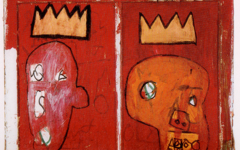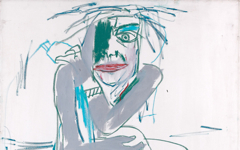Basquiat’s Boy and Dog in a Johnnypump (1982)
Boy and Dog in a Johnnypump is an important painting which does not appear to make much sense. We can, however, learn something about it. Both figures (including the dog) must, according to the principles of this site, be self-representations of the artist with the subject, as always, art. Knowledge of an artist's forms helps too because no matter what the apparent scene, if a form is borrowed from elsewhere, that new form carries with it some of the old meaning.
Click next thumbnail to continue
That's lucky because the year before, in 1981, Basquiat had sketched on paper a tormented self-portrait with a crown of thorns in which he spreads his hands outwards. Thus, based on what we know of earlier art, the tormented Christ-head is likely to symbolize the agony of conception with the hands as a symbol of his craft. Eyewitness descriptions attest to the importance of Basquiat's hand. One said: "I never had any doubt he was a genius; not after I saw him with a pencil in his hand."1 Another: "It was amazing this whole dance he did with a pencil."2
Click next thumbnail to continue
When a figure spreads his arms the next year in a painting of a boxer, we can assume again that the underlying meaning remains the same. Creating art is a struggle, Basquiat says, and like a boxer I must fight my way to the top using the magic of my hands.
Click next thumbnail to continue
So, what have we learnt? We can be certain, based on these other images and no longer just on the assumptions of this site, that the boy also represents the artist. He even seems to retain some of the struggle and torment of the boxer and the earlier self-portrait. Paint, too, dripping from the boy's hands suggests the blood of crucifixion. There is still much to learn about this painting but we have made a start and, perhaps, learned a useful lesson: form carries meaning.
More Works by Basquiat
Notes:
1. Glenn O'Brien in Basquiat (Basle: Hatje Cantz) 2010, p. II
2. Fab 5 Freddy, quoted in ibid., p. XI
Original Publication Date on EPPH: 21 Nov 2010. | Updated: 0. © Simon Abrahams. Articles on this site are the copyright of Simon Abrahams. To use copyrighted material in print or other media for purposes beyond 'fair use', you must obtain permission from the copyright owner. Websites may link to this page without permission (please do) but may not reproduce the material on their own site without crediting Simon Abrahams and EPPH.







